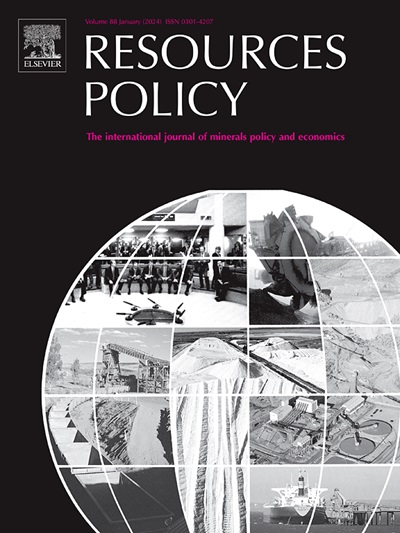Towards sustainable mine closure and reclamation through strategic tailing disposal sites evaluation: A causality-based Dempster-Shafer framework
IF 10.2
2区 经济学
0 ENVIRONMENTAL STUDIES
引用次数: 0
Abstract
Tailings, the byproducts of mineral processing, present substantial environmental risks, both physically and chemically, including potential irreversible ecological damage if not properly managed. This study introduces a hybrid decision-support framework for evaluating strategic tailings disposal sites by integrating sustainability, mine closure planning, and risk-informed governance. A key innovation is the direct linkage between tailings siting and mine reclamation strategies, offering new insights for sustainable mining. The framework combines fuzzy cognitive mapping (FCM) for causal analysis with Dempster-Shafer Theory (DST)-based evidential reasoning to address uncertainty and expert judgment variability. Twelve site selection criteria were identified from literature and expert consultation, with interdependencies modeled using a hybrid nonlinear Hebbian learning–differential evolution (NHL-DE) FCM algorithm. The approach was applied to the Zarshouran Gold Mine in Iran to support decisions in line with global tailings governance frameworks such as the Global Industry Standard on Tailings Management (GISTM). DST was used to compute belief degrees for alternative sites, reflecting environmental, technical, and socio-economic factors. Results revealed that “Socioeconomic impact on downstream communities” and “Engineering challenges” were the most influential criteria (both with normalized causal weights of 0.110). The most favorable site, located near the processing plant, achieved an 84.6 % belief degree at the “Good-Excellent” level, followed by a site near the pit (82.4 %). By streamlining methodology and emphasizing site-specific insights, the framework offers a robust tool for prioritizing tailings sites under uncertainty, aligning technical evaluations with ESG principles and mine closure objectives.
通过战略性尾矿处置场地评价实现可持续的矿山关闭和复垦:基于因果关系的Dempster-Shafer框架
尾矿是矿物加工的副产品,在物理和化学方面对环境造成重大危害,包括如果管理不当可能造成不可逆转的生态破坏。本研究引入了一个混合决策支持框架,通过整合可持续性、矿山关闭规划和风险知情治理来评估战略性尾矿处置场地。一个关键的创新是尾矿选址和矿山复垦战略之间的直接联系,为可持续采矿提供了新的见解。该框架将用于因果分析的模糊认知映射(FCM)与基于Dempster-Shafer理论(DST)的证据推理相结合,以解决不确定性和专家判断的可变性。从文献和专家咨询中确定了12个选址标准,并使用混合非线性Hebbian学习-差分进化(NHL-DE) FCM算法对相互依赖关系进行建模。该方法已应用于伊朗Zarshouran金矿,以支持符合全球尾矿管理行业标准(gism)等全球尾矿治理框架的决策。DST用于计算可选地点的可信度,反映环境、技术和社会经济因素。结果显示,“对下游社区的社会经济影响”和“工程挑战”是最具影响力的标准(两者的归一化因果权重均为0.110)。最有利的地点位于加工厂附近,达到84.6%的“良好-优秀”水平,其次是靠近矿坑的地点(82.4%)。通过简化方法和强调具体地点的见解,该框架提供了一个强大的工具,可以在不确定的情况下确定尾矿地点的优先次序,使技术评估与ESG原则和矿山关闭目标保持一致。
本文章由计算机程序翻译,如有差异,请以英文原文为准。
求助全文
约1分钟内获得全文
求助全文
来源期刊

Resources Policy
ENVIRONMENTAL STUDIES-
CiteScore
13.40
自引率
23.50%
发文量
602
审稿时长
69 days
期刊介绍:
Resources Policy is an international journal focused on the economics and policy aspects of mineral and fossil fuel extraction, production, and utilization. It targets individuals in academia, government, and industry. The journal seeks original research submissions analyzing public policy, economics, social science, geography, and finance in the fields of mining, non-fuel minerals, energy minerals, fossil fuels, and metals. Mineral economics topics covered include mineral market analysis, price analysis, project evaluation, mining and sustainable development, mineral resource rents, resource curse, mineral wealth and corruption, mineral taxation and regulation, strategic minerals and their supply, and the impact of mineral development on local communities and indigenous populations. The journal specifically excludes papers with agriculture, forestry, or fisheries as their primary focus.
 求助内容:
求助内容: 应助结果提醒方式:
应助结果提醒方式:


